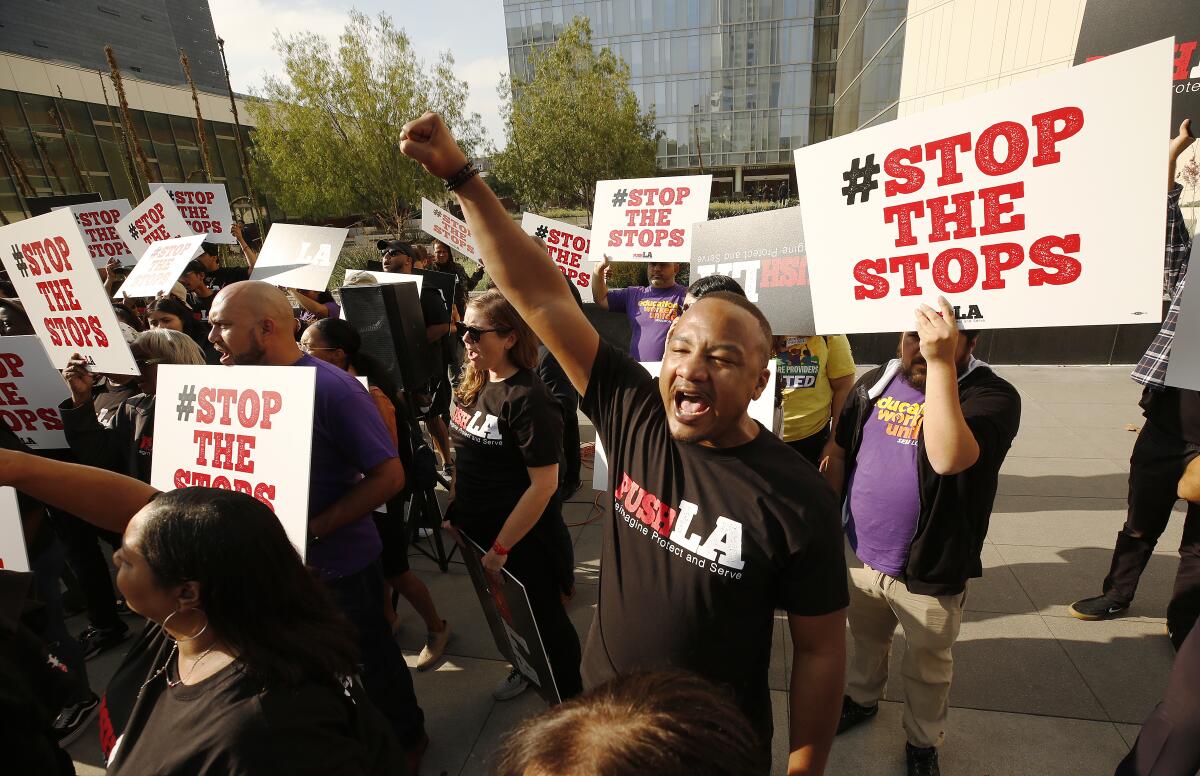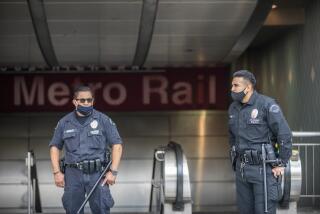Desperate to slow spike in killings, LAPD redeploys controversial units in South L.A.

- Share via
Facing a troubling spike in gun violence, the Los Angeles Police Department has returned tactical officers to crime suppression and vehicle stops in South L.A. and other neighborhoods, after critics called the tactics racially biased and department leaders determined two years ago that they were ineffective.
The move, which The Times confirmed this week, speaks to a growing desperation among police and others to curb the dramatic spike in homicides and shootings that began in 2020 with the pandemic but has continued unabated in the first weeks of 2021.
Through the end of January, homicides were up 40% compared with the same time last year and up 111% compared with 2019; much of the violence occurred in South and Central L.A., according to police data. The city this week saw its 50th homicide of the year, compared with 31 during the same period last year. Shootings were up more than 160%.
The move to reinstate “investigative stops” immediately raised concerns among some longtime police observers at a time of increased scrutiny over LAPD tactics in communities of color.
Officers from the same Metropolitan Division were sent into South L.A. several years ago in response to another increase in violent crime. But in 2019, LAPD Chief Michel Moore largely curtailed the program after The Times found that Metro officers stopped Black drivers at a rate more than five times their share of the city’s population and twice their share of the population in South L.A. Moore said at the time that an analysis had also shown that the stops were ineffective, netting just one arrest for every 100 cars stopped.
This week, Moore said Metro officers had been deployed in their new crime suppression roles for “several weeks” in response to rising shootings and homicides.
The officers are working in uniform and conducting “investigative stops” based on “information gleaned from crime alerts, real-time statistics and communication with the area commanding officers regarding the most recent crime trends,” Moore said. They are “held to a high standard and mandated to engage in constitutional policing, which relies on reasonable suspicion and probable cause for detentions and arrests,” he added.
The officers are also serving search and arrest warrants and apprehending wanted suspects, Moore said.
As of Friday, the Metro officers had conducted 74 stops, resulting in 50 arrests and 38 guns recovered — a vastly greater rate of arrests and seizures than during stops in the past, according to LAPD data. In 2019, officers made 15,802 stops, leading to about 1,800 arrests and the recovery of 200 guns, the LAPD said.
Moore noted the smaller scope of the latest deployments and said they were getting results.
“We have bolstered patrols in those communities most impacted by gun violence,” he said. “We know as a profession, and data shows, increased police presence when approached correctly reduces violence and improves trust.”
Capt. Stacy Spell, an LAPD spokesman, said the department could not immediately provide the demographics of the drivers involved.
Metro’s swarm approach had been the cornerstone of the department’s crime-fighting strategy, but the practice increasingly came under fire for its disproportionate effect on Black and Latino drivers. In 2020, the number of stops plummeted from the year prior, to 423.
In October, a review of hundreds of thousands of LAPD stops by the department’s inspector general found that strategies to use traffic and other minor violations “as a pretext to identify or suppress more serious crimes” had subjected Black and Latino drivers to far more stops than white drivers, even though they were less likely to be caught with contraband, and the stops were “of limited effectiveness in identifying evidence of illegal firearms or other serious crimes.”
The surge in violent crime has been concentrated in South and Central L.A., including in some neighborhoods that did not see killings in the early days of 2020. Police blame gangs and an increase in tension among and directed toward people experiencing homelessness; that population has been overrepresented among the slain, as it was in 2020.
Last year’s violence — 350 homicides and many more shootings — was the most seen in the city in a decade, though well below historic highs in the 1990s.
Moore in recent weeks has expressed frustration with the shootings, which he has attributed in part to gang members becoming increasingly bold about carrying firearms in their cars and willing to spontaneously open fire in retaliatory violence against rival sects.
The gunfire is mostly occurring on the streets, near homeless encampments, on sidewalks and in parking lots. There were 130 shootings in the first four weeks of this year, compared with 47 in the same period last year and 49 in 2019, police data show.
“This far outpaces anything we have seen in the recent past,” Moore said. “We continue to struggle.”
Connie Rice, a civil rights attorney who helped challenge the Metro stops of the past, said it makes sense that the LAPD is looking for answers to the violence, but the new deployments raise questions — particularly given the department’s problematic track record with investigative stops.
“If the stops are based on investigations and intelligence about specific gangs that they know are engaged in shooting, that’s one thing,” Rice said. “If, however, ‘reasonable suspicion’ is the old LAPD standard ... which is basically any Black male between 18 and 30 who looks like a gang member, or a Black man in a car with paper plates, they’re back to a 1% solution and unconstitutional policing.”
Chris Burbank, vice president of law enforcement strategy for the Center for Policing Equity, said any decision to return to a program that in a previous iteration showed little effectiveness and produced large community disparities should raise red flags. In policing, “data needs to drive your decision to do any type of activity,” he noted.
Melanie Ochoa, a senior staff attorney with the ACLU of Southern California, said she is concerned by the new deployments and wants to know whether they are designed to avoid the “incredibly skewed” results of the past — such as Black and Latino residents being subjected to “much more severe and frequent enforcement practices.”
“I’m worried that they have just agreed to shut these things down, and then just restarted them under a different name,” Ochoa said. “I question whether the department can be trusted to live up to its own word about its willingness to respond to criticisms about how it is policing different communities.”
LAPD Inspector General Mark Smith, whose office in October reported finding racial disparities in past investigative stops, said he will continue to regularly monitor data on the department’s stop activity.
“We are aware that there will be fluctuations in the Department’s stop activity from time to time and place to place, based on a variety of constantly changing factors,” Smith said in a statement. “Our goal is to ensure that the Department is conducting stops constitutionally, equitably, professionally, and in a manner that best serves the needs of the Los Angeles community.”
The Metro deployments are just one shift in a broader restructuring by the LAPD as it struggles to respond to the violence, new reform mandates and a trim to its budget. The department this weekend will implement a raft of redeployments, downsizing certain specialized crime units in favor of patrol and community policing programs. It also has begun diverting some 911 calls to non-emergency services.
On Tuesday, the LAPD said that since November its 911 dispatchers had diverted 320 calls to the city’s non-emergency number, 736 to the county’s non-emergency number and more than 1,000 to its online reporting portal.
Some see the broader reshuffling as a necessary step in the city’s ongoing effort to reimagine public safety and redirect police funding to other social services in the wake of widespread protests last summer. Others have denounced it as an invitation for more violence at exactly the wrong time.
Moore has said the restructuring would not diminish the department’s commitment to preventing and responding to crime and cited increases in gun seizures as proof that his officers are continuing to work effectively.
Spell could not say whether the new Metro stops had contributed to the increase in gun seizures.
Criminologists and local officials have noted that increases in violence have occurred since last year in cities across the country, suggesting that the COVID-19 pandemic may be more to blame than localized factors like police deployments or budget cuts. Many believe little will change on the crime front until the impacts of the pandemic — upended economic and social foundations, crippled anti-violence initiatives, drained city coffers and new strains on the criminal justice system — begin to be reversed.
Moore said he believes the closure of schools, recreation centers and other places where community members would normally come together to “talk and work through difficulties” has contributed to the violence, as has the fact that intervention workers have been prohibited from responding to shootings as they used to, including at the bedside of potentially vengeful gunshot victims.
He said he hopes the pandemic’s grip will loosen this year, because police “will not solve this increase in violence by enforcement alone.”











